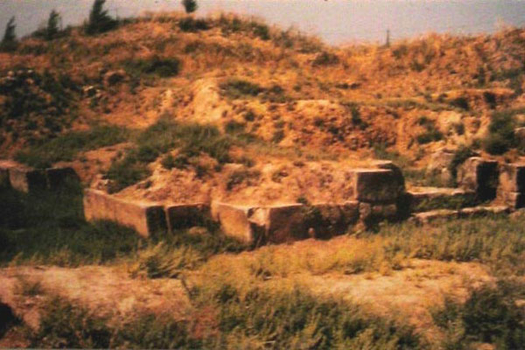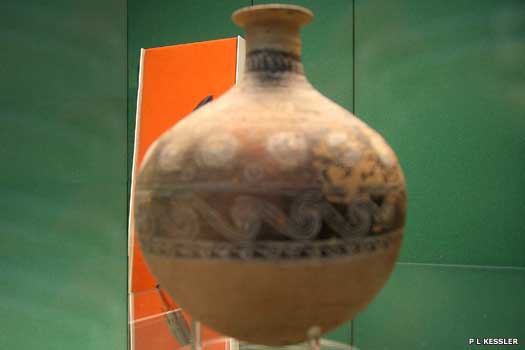
| ALAKHTUM / ALALAKH Alakhtum / Alalakh :
Founded (or re-founded) as one of a wave of early city states in Syria during the first part of the second millennium BC, Alakhtum (or later, Alalakh) was a small Amorite city state which was situated to the west of the larger Syrian state of Yamkhad, about fifty kilometres from the River Orontes. For a time, the city was one of many which was under Yamkhad's control. Probably created to control the trade routes between Sumer and the Hatti in Anatolia, it was called Alakhtum at least until the eighteenth century BC, as shown by records from Mari.
Alakhtum consists of eighteen layers of occupation, dating from around 3400 BC (Layer XVII) to around 1200 BC (Layer 0). The archives at Alalakh (modern Tell Atchana, now in southern Turkey) were discovered to be comparable in size to those at Ugarit and Mari when they were unearthed by Sir Leonard Woolley in the 1930s and 1940s. Most of these date from the Middle and Late Bronze Ages (2000-1200 BC, or Layers VIII to 0), with the story of Idrimi being noted in especial prominence and detail.
c.3400 BC :
Alakhtum is first founded as a permanent settlement, located to the west of the larger Syrian state of Yamkhad, about fifty kilometres from the River Orontes. Its fortunes remain largely unknown until the city is re-founded at the beginning of the second millennium BC.
fl c.2700 BC :
? : Unnamed king.
c.2700 BC :
The city is already established by this date, and the king of Alakhtum now adorns the facade of his palace with huge columns built of specially-moulded mud bricks, a fashion set by his Sumerian clients such as those who have already built the colonnades of Warka and Kish.
c.2000 BC :
The first palace is constructed at now-Amorite Alalakh, contemporary with the last days of the third dynasty at Ur. The city is probably a vassal of Yamkhad by this point, and is certainly so by the eighteenth century BC.
This view of part of Alalakh's present-day excavated remnants shows the Level VII (Middle Bronze Age) city gate and the entrance into one of the guard chambers, all of which would have been destroyed by the Hittite attack of about 1650-1620 BC c.1780s BC :
Sumu'epuh of Yamkhad sells Alakhtum to his son-in-law, Zimri-Lim, who possibly rules here before his capture of Mari in c.1776 BC.
c.1780s - 1761 BC :
Zimri-Lim? : King of Mari & Terqa (c.1776-1761 BC).
c.1761 BC :
With the fall of Mari to Babylon, Alakhtum seems to fall back under the control of Yamkhad. Hurrians begin migrating west from Urkesh and Nawar in this period, settling in cities such as Alakhtum. The reason for this migration are unclear, but may be due to Mari's control of the Hurrian city of Urkesh having been removed.
fl c.1750s BC :
Yarim-Lim / Iarimlim : Placed on throne by his brother, Abba'el of Yamkhad.
c.1750s BC :
Yarim-Lim, brother of Abba-el of Yamkhad, is placed on the throne as a vassal king and begins a dynasty of such rulers which survives until the city is destroyed by the Hittites. (This begins Level VII of the city in archaeological terms.)
Ammitaqum : Son. Long reign ended during rule of Yarim-Lim III of Yamkhad.
? - c.1620 BC :
Hammurabi : Relationship unknown. Not the same Hammurabi as in Yamkhad.
c.1650 - 1620 BC :
Under Hattusili I, the Hittites attack and destroy several of Yamkhad's vassals over several years, including Alalakh. Yarim-Lim's dynasty of rulers is ended, and written records cease until the first half of the 1400s BC. This ends Alalakh's Level VII phase of building and habitation.
Alalakh (City State of Mukish) :
In the 1480s or 1470s BC, Idrimi, son of the king of Alep, was forced to flee his homeland. He passed through Ebla (where he met King Zakkar) and ended up in Emar. From there he organised the storming of Alakhtum by sea with his band of habiru followers. Unfortunately, although Idrimi's kingdom is documented, the administration of the restored city before the storming is entirely unrecorded. There may have been a local ruler in charge, but more probably the city had been restored under a governor of the Mitanni empire. Although Idrimi himself is rarely documented, his successors appear regularly in tablets from the region. His rule begins Level IV of the city's archaeological record.
fl c.1470s BC :
Idrimi : Son of the king of Alep. Reigned for 30 years.
c.1470 BC :
Idrimi contacts the king of Mitanni, Parattarna (Barattarna), who endorses Idrimi's rule of the city, making him a Mitanni vassal. Under Idrimi's vigorous rule, the state expands, enriching itself by frequent raids on Hittite territory. Kizzuwatna is also forced to sign a treaty with Idrimi. By the time Idrimi's son ascends the throne, Alalakh also controls the minor city of Nuhassa (Nuhašše / Nuhašša), to the south of Alep, and that of Niye, much less than the territory formerly controlled by Alep.
Addu-nirari / Adad-Nerari : Son. Not on all lists.
c.1450 - 1425 BC :
Niqmepuh / Niqmepa : Brother. Contemporary of Saushtatar of Mitanni.
It seems that at some point, Niqmepuh extends his territorial control from the family's new home in Alakhtum to reclaim his ancestral seat in Alep.
fl c.1420 BC :
Ilim-ilimma (II) : Son. Also king of Alep.
At some point around this time the Hittites manage to make Alakhtum a vassal state.
Ituraddu
? - c.1370 BC :
Mukish : Vassal of the Hittites.
Suppiluliuma, the new Hittite ruler, takes control of northern Syria. Ugarit informs the Hittites of a planned revolt by Alalakh (which they call Mukish), so the kingdom and its dependents, Nuhassa and Niye, are incorporated directly into the empire, with their lands being assigned to Ugarit as a reward.
'Atchana Ware' from Alalakh Levels III-II (1370-1270 BC) c.1200 BC :
Alalakh is destroyed, probably by the Sea Peoples, during the collapse of the Hittite empire and is never re-occupied, its place being taken by the nearby Iron Age port of al Mina.
Source :
https://www.historyfiles.co.uk/ |

